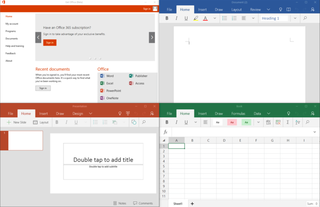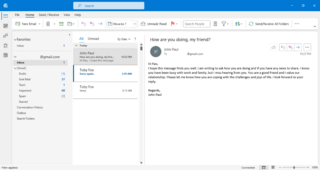
Microsoft Office, or simply Office, is a family of client software, server software, and services developed by Microsoft. It was first announced by Bill Gates on August 1, 1988, at COMDEX in Las Vegas. Initially a marketing term for an office suite, the first version of Office contained Microsoft Word, Microsoft Excel, and Microsoft PowerPoint. Over the years, Office applications have grown substantially closer with shared features such as a common spell checker, Object Linking and Embedding data integration and Visual Basic for Applications scripting language. Microsoft also positions Office as a development platform for line-of-business software under the Office Business Applications brand.
Visual Basic for Applications (VBA) is an implementation of Microsoft's event-driven programming language Visual Basic 6.0 built into most desktop Microsoft Office applications. Although based on pre-.NET Visual Basic, which is no longer supported or updated by Microsoft, the VBA implementation in Office continues to be updated to support new Office features. VBA is used for professional and end-user development due to its perceived ease-of-use, Office's vast installed userbase, and extensive legacy in business.

Microsoft Outlook is a personal information manager software system from Microsoft, available as a part of the Microsoft 365 software suites. Though primarily being popular as an email client for businesses, Outlook also includes functions such as calendaring, task managing, contact managing, note-taking, journal logging, web browsing, and RSS news aggregation.
Virtual PC is a discontinued x86 emulator for PowerPC Mac hosts and Microsoft Windows hosts. It was created by Connectix in 1997 and acquired by Microsoft in 2003. The Mac version was discontinued in 2006 following the Mac transition to Intel, while the Windows version was discontinued in 2011 in favour of Hyper-V.

Windows 7 is a major release of the Windows NT operating system developed by Microsoft. It was released to manufacturing on July 22, 2009, and became generally available on October 22, 2009. It is the successor to Windows Vista, released nearly three years earlier. Windows 7's server counterpart, Windows Server 2008 R2, was released at the same time. It was succeeded by Windows 8 in October 2012.
Remote Desktop Protocol (RDP) is a proprietary protocol developed by Microsoft Corporation which provides a user with a graphical interface to connect to another computer over a network connection. The user employs RDP client software for this purpose, while the other computer must run RDP server software.

Microsoft Project is project management software product, developed and sold by Microsoft. It is designed to assist a project manager in developing a schedule, assigning resources to tasks, tracking progress, managing the budget, and analyzing workloads.

Microsoft Office 2003 is an office suite developed and distributed by Microsoft for its Windows operating system. Office 2003 was released to manufacturing on August 19, 2003, and was later released to retail on October 21, 2003. The Mac OS X equivalent, Microsoft Office 2004 for Mac was released on May 11, 2004.

Microsoft Office XP is an office suite which was officially revealed in July 2000 by Microsoft for the Windows operating system. Office XP was released to manufacturing on March 5, 2001, and was later made available to retail on May 31, 2001. A Mac OS X equivalent, Microsoft Office v. X was released on November 19, 2001.

Windows Server Essentials is an integrated server suite from Microsoft for businesses with no more than 25 users or 50 devices. It includes Windows Server, Exchange Server, Windows SharePoint Services, and Microsoft Outlook. Application server technologies are tightly integrated to provide and offer management benefits such as integrated setup, enhanced monitoring, Remote Web Workplace, a unified management console, and remote access.

Windows Vista is a major release of the Windows NT operating system developed by Microsoft. It was the direct successor to Windows XP, released five years earlier, which was then the longest time span between successive releases of Microsoft Windows. It was released to manufacturing on November 8, 2006, and over the following two months, it was released in stages to business customers, original equipment manufacturers (OEMs), and retail channels. On January 30, 2007, it was released internationally and was made available for purchase and download from the Windows Marketplace; it is the first release of Windows to be made available through a digital distribution platform.

Microsoft Office 2007 is an office suite for Windows, developed and published by Microsoft. It was officially revealed on March 9, 2006 and was the 12th version of Microsoft Office. It was released to manufacturing on November 3, 2006; it was subsequently made available to volume license customers on November 30, 2006, and later to retail on January 30, 2007. The Mac OS X equivalent, Microsoft Office 2008 for Mac, was released on January 15, 2008.
Windows Vista—a major release of the Microsoft Windows operating system—was available in six different product editions: Starter, Home Basic, Home Premium, Business, Enterprise, and Ultimate. On September 5, 2006, Microsoft announced the USD pricing for editions available through retail channels; the operating system was later made available to retail on January 30, 2007. Microsoft also made Windows Vista available for purchase and download from Windows Marketplace; it is the first version of Windows to be distributed through a digital distribution platform. Editions sold at retail were available in both Full and Upgrade versions and later included Service Pack 1 (SP1).

Microsoft Office 2010 is a version of Microsoft Office for Microsoft Windows unveiled by Microsoft on May 15, 2009, and released to manufacturing on April 15, 2010, with general availability on June 15, 2010. The macOS equivalent, Microsoft Office 2011 for Mac was released on October 26, 2010.

Microsoft Office 2008 for Mac is a version of the Microsoft Office productivity suite for Mac OS X. It supersedes Office 2004 for Mac and is the Mac OS X equivalent of Office 2007. Office 2008 was developed by Microsoft's Macintosh Business Unit and released on January 15, 2008. Office 2008 was followed by Microsoft Office for Mac 2011 released on October 26, 2010, requiring a Mac with an Intel processor and Mac OS version 10.5 or better. Office 2008 is also the last version to feature Entourage, which was replaced by Outlook in Office 2011. Microsoft stopped supporting Office 2008 on April 9, 2013.
This is a history of the various versions of Microsoft Office, consisting of a bundle of several different applications which changed over time. This table only includes final releases and not pre-release or beta software. It also does not list the history of the constituent standalone applications which were released much earlier starting with Word in 1983, Excel in 1985, and PowerPoint in 1987.

Microsoft Office for Mac 2011 is a version of the Microsoft Office productivity suite for macOS. It is the successor to Microsoft Office 2008 for Mac and is comparable to Office 2010 for Windows. Office 2011 was followed by Microsoft Office 2016 for Mac released on July 9, 2015, requiring a Mac with an x64 Intel processor and OS X Yosemite or later. Office for Mac 2011 is no longer supported as of October 10, 2017. Support for Lync for Mac 2011 ended on October 9, 2018.

Microsoft Office 2013 is a version of Microsoft Office, a productivity suite for Microsoft Windows. Unlike with Office 2010, no macOS equivalent was released.

Microsoft Office 2019 is a version of Microsoft Office for both Windows and Mac. It was unveiled on April 27, 2018, for Microsoft Windows and June 12, 2018, for macOS, and launched on September 24, 2018. Some features that had previously been restricted to Office 365 subscribers are available in this release. Office 2019 retains the same major version number of 16, making it the second perpetual release of Office 16. Unlike other versions of Microsoft Office, Office 2019 will only get two years of extended support, which means that support for Office 2019 will end on October 14, 2025.

Microsoft Office 2021 is a version of the Microsoft Office suite of applications for the Microsoft Windows and macOS operating systems. It was released on October 5, 2021. A successor, Microsoft Office 2024 is expected to be rolled out in the second half of 2024.

















